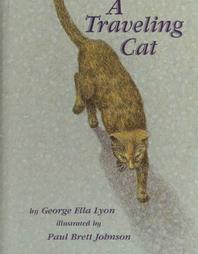
George Ella Lyon was approaching 50 when she set down her childhood memories of a cat she’d found in a small mining town in Kentucky. The cat’s name is Boulevard. You see her silhouette on a trestle bridge over a grassy, tree-lined river – with blue mountains in the background. “I found her at the drive-in movie,” writes George Ella Lyon, “on the playground in front of the screen.” The cat on the playground sits attentively, bravely studying a little girl with its ears perked up – but in the background are classic cars from the 1950s. It’s not only a cat’s perspective – it’s a cat’s perspective from the distant past.
Each page in A Traveling Cat shows beautiful, moody illustrations that show the world in colored chalk – the shades of color in the sky, the bright green of a field – and they make the familiar seem special and magic. When autumn comes, the trees turn orange and yellow. And ironically, one of the most beautiful drawings is on the page with the copyright notice. It’s a two-page spread showing dawn’s light over dark and purple hills. The traveling cat’s road is streaks of yellow, orange, purple, and blue. It’s as though the whole world was being seen through the eyes of a cat.
A little girl named Ruth discovers the cat at a drive-in. Relaxing on the wide upholstery of the car is the girl’s father, who seems friendly – and the whole family seems to enjoy the cat. The drawings capture everyone’s personality. The father lifts the cat proudly, Ruth cradles the cat affectionately, and the text also seems to add to the personalities as well. (“‘Ruth’s found a hitcher!’ he said, picking Bouvie up. ‘Now whose little cat could you be?'”) She watches squirrels, dances in the snow, and catches a ride on the family’s beagle, Roscoe. “Bouvie DID swing from the curtains,” Johnson remembers, “but even Mom said she was graceful.”)
But the text reads like poetry. (“Bouvie had a night-colored coat splattered with gold, like stars.”) And it captures the mystery of life with a cat. The cat disappears for a week, then surprises the family with kittens. On a stormy night she walks through the door, and drops the tiny kitten at their feet. Then does it four my times, depositing five kittens.
Two pages later they’re all given away. And when a flood swamps the town, all the neighborhood’s pets disappear. The animals fled to high ground in the hills – but they never came back. There’s an empty drive-in theatre, with two sad people in the foreground.”All summer I’ve looked for my cat, especially at the drive-in.”
The cat’s gone for good. The book imagines her wandering up a shadowy road with the sunlight through the leaves. But the book finds a positive philosophical note to end on. “Dad says Boulevard stayed a long time for such a traveling cat.
“Maybe, but not long enough.”